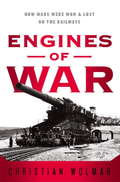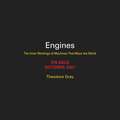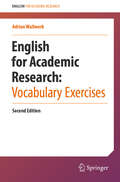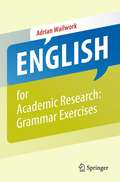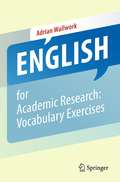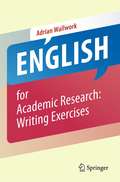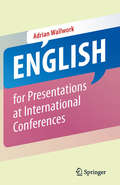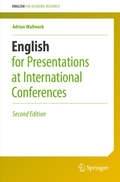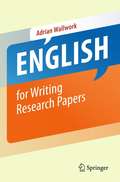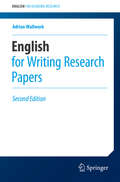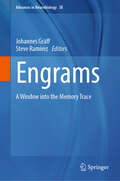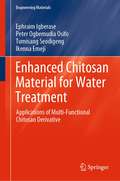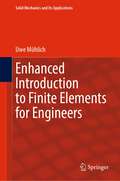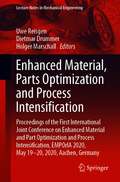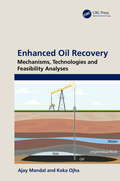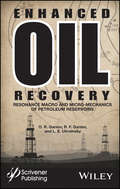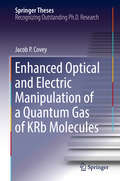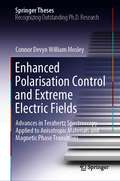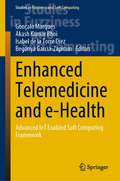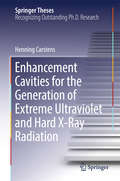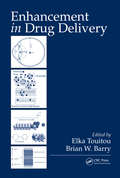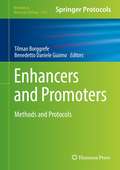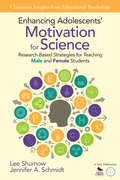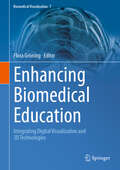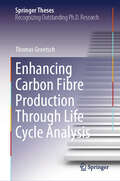- Table View
- List View
Engines of War: How Wars Were Won & Lost on the Railways
by Christian WolmarBefore the nineteenth century, armies had to rely on slow and unreliable methods of transportation to move soldiers and equipment during times of conflict. But with the birth of the railroad in the early 1830s, the way wars were fought would change forever. In Engines of War, renowned expert Christian Wolmar tells the story of that transformation, examining all the engagements in which railways played a part from the Crimean War and American Civil War through both world wars, the Korean War, and the Cold War with its mysterious missile trains. He shows that the 'iron road' not only made armies far more mobile, but also greatly increased the scale and power of available weaponry. Wars began to be fought across wider fronts and over longer timescales, with far deadlier consequences. From armored engines with their swiveling guns to track sabotage by way of dynamite, railway lines constructed across frozen Siberian lakes and a Boer war ambush involving Winston Churchill, Engines of War shows how the railways - a fantastic generator of wealth in peacetime - became a weapon of war exploited to the full by governments across the world.
Engines: The Inner Workings of Machines That Move the World
by Theodore GrayThe international bestselling author of How Things Work and The Elements Trilogy turns his focus to a visual exploration of the inner workings and functionality of the marvelous machines that run our world—from the first steam engines to giant turbines to today's tiny electrical engines. In Engines, the always entertaining and informative Theodore Gray explores the glorious guts and intricate innards of dozens of impressive machines. Through his engaging and unexpected stories and Nick Mann&’s trademark gorgeous photography, Gray takes us on a journey from ancient Greek steam engines to our most sophisticated twenty-first-century machinery. We take time to appreciate the detailed functionality of the internal combustion engine, the connection between magnetism and electric motors, as well as hydraulics, robotics, and more. Each chapter builds on the previous, illuminating the evolution of engines and revealing the ingenuity brought to bear as humans invented and perfected these marvelous mechanical systems. Along the way, Gray regales us with tales of his own experiences working with and collecting these machines. For fans of how things are made and how they work, Engines is a loving tribute to the mechanical world.
English for Academic Research: Vocabulary Exercises (English for Academic Research)
by Adrian WallworkThis book is based on a study of referees' reports and letters from journal editors on reasons why papers written by non-native researchers are rejected due to problems with English (long sentences, redundancy, poor structure etc.). It draws on English-related errors from around 5000 papers written by non-native authors, around 3000 emails, 500 abstracts by PhD students, and over 1500 hours of teaching researchers how to write and present research papers. The exercises are organized into thirteen chapters on: adjectives and adverbs (e.g. actual vs current, different vs several, continually vs continuously), link words (e.g. on the contrary vs on the other hand, despite vs nevertheless), nouns (e.g. danger vs hazard, measure vs measurement), prepositions (e.g. among vs between, in vs into, with vs within), verbs (e.g. check vs control, compose vs comprise, arise vs raise, exclude vs rule out), false friends and synonyms, spelling, useful phrases, inclusive vocabulary, emails, using Large Language Models for correcting, paraphrasing, and translating.Nearly all exercises require no actual writing but simply choosing between various options, thus facilitating self-study, e-reading and rapid progress.The exercises can also be integrated into English for Academic Purposes (EAP) and English for Special Purposes (ESP) courses at universities and research institutes.The book can be used in conjunction with the other exercise books in the series:English for Academic Research: Writing ExercisesEnglish for Academic Research: Grammar ExercisesAdrian Wallwork edits scientific papers and teaches English for Academic Purposes (EAP) to PhD students. In addition to his many books for Springer, he has written course books for Oxford University Press and discussion books for Cambridge University Press.
English for Academic Research: Grammar Exercises
by Adrian WallworkThis book is based on a study of referees' reports and letters from journal editors on reasons why papers written by non-native researchers are rejected due to problems with English grammar. It draws on English-related errors from around 5000 papers written by non-native authors, several hundred emails, 500 abstracts by PhD students, and over 1000 hours of teaching researchers how to write and present research papers. The exercises include the following areas: active vs passive, use of wearticles (a/an, the, zero) and quantifiers (some, any, few etc)conditionals and modalscountable and uncountable nounsgenitiveinfinitive vs -ing formnumbers, acronyms, abbreviationsrelative clauses and which vs thattenses (e.g. simple present, simple past, present perfect)word orderExercise types are repeated for different contexts. For example, the difference between the simple present, present perfect and simple past is tested for use in papers, referees' reports, and emails of various types. Such repetition of similar types of exercises is perfect for revision purposes. English for Academic Research: Grammar Exercises is designed for self-study and there is a key to all exercises. Most exercises require no actual writing but simply choosing between various options, thus facilitating e-reading and rapid progress. The exercises can also be integrated into English for Academic Purposes (EAP) and English for Special Purposes (ESP) courses at universities and research institutes. The book can be used in conjunction with the other exercise books in the series and is cross-referenced to: English for Research: Usage, Style, and GrammarEnglish for Writing Research PapersEnglish for Academic Correspondence and Socializing Adrian Wallwork is the author of around 30 ELT and EAP textbooks. He has trained several thousand PhD students from 35 countries to write and present academic work. English for Writing Research PapersEnglish for Academic Correspondence and Socializing Adrian Wallwork is the author of around 30 ELT and EAP textbooks. He has trained several thousand PhD students from 35 countries to write and present academic work. English for Academic Correspondence and Socializing Adrian Wallwork is the author of around 30 ELT and EAP textbooks. He has trained several thousand PhD students from 35 countries to write and present academic work.
English for Academic Research: Vocabulary Exercises
by Adrian WallworkThis book is based on a study of referees' reports and letters from journal editors on reasons why papers written by non-native researchers are rejected due to problems with English (long sentences, redundancy, poor structure etc). It draws on English-related errors from around 5000 papers written by non-native authors, around 3000 emails, 500 abstracts by PhD students, and over 1000 hours of teaching researchers how to write and present research papers. The exercises are organized into nine chapters on: adjectives and adverbs (e.g. actual vs current, different vs several, continually vs continuously), link words (e.g. on the contrary vs on the other hand, despite vs nevertheless), nouns (e.g. danger vs hazard, measure vs measurement), prepositions (e.g. among vs between, in vs into, with vs within), verbs (e.g. check vs control, compose vs comprise, arise vs raise, exclude vs rule out), false friends and synonyms, spelling, useful phrases, emails Nearly all exercises require no actual writing but simply choosing between various options, thus facilitating self-study, e-reading and rapid progress. The exercises can also be integrated into English for Academic Purposes (EAP) and English for Special Purposes (ESP) courses at universities and research institutes. The book can be used in conjunction with the other exercise books in the series: English for Academic Research: Writing Exercises English for Academic Research: Grammar Exercises
English for Academic Research: Writing Exercises
by Adrian WallworkThis book is based on a study of referees' reports and letters from journal editors on reasons why papers written by non-native researchers are rejected due to problems with English (long sentences, redundancy, poor structure etc). It draws on English-related errors from around 5000 papers written by non-native authors, around 3000 emails, 500 abstracts by PhD students, and over 1000 hours of teaching researchers how to write and present research papers. The exercises are organized into ten chapters on: punctuation and spellingword orderwriting short sentences and paragraphslink words - connecting phrases and sentences togetherbeing concise and removing redundancyambiguity and political correctnessparaphrasing and avoiding plagiarismdefining, comparing, evaluating and highlightinganticipating possible objections, indicating level of certainty, discussion limitations, hedging, future workwriting each section of a paperSome exercises require no actual writing but simply choosing between various options, thus facilitating self-study, e-reading and rapid progress. In those exercises where extended writing is required, model answers are given. Exercise types are repeated for different contexts, for example the importance of being concise is tested for use in papers, referees' reports, and emails of various types. Such repetition of similar types of exercises is designed to facilitate revision. The exercises can also be integrated into English for Academic Purposes (EAP) and English for Special Purposes (ESP) courses at universities and research institutes. The book can be used in conjunction with the other exercise books in the series and is cross-referenced to: English for Research: Usage, Style, and Grammar English for Writing Research Papers
English for Presentations at International Conferences
by Adrian WallworkGood presentation skills are key to a successful career in academia. This book is the first guide to giving presentations at international conferences specifically written for researchers of all disciplines whose first language is not English.<P><P> With easy-to-follow rules and tips, and with examples taken from real presentations, you will learn how to:<P> * avoid errors in English by using short easy-to-say sentences<P> * improve your English pronunciation and intonation<P> * gain confidence, and overcome nerves and embarrassment<P> * plan, prepare and practice a well-organized, interesting presentation<P> * highlight the essential points you want your audience to remember<P> * deal with questions from the audience<P> * decide what to say at each stage of the presentation<P> * use standard phrases<P> * attract and retain audience attention
English for Presentations at International Conferences, Second edition
by Adrian WallworkGood presentation skills are key to a successful career in academia. This guide provides examples taken from real presentations given both by native and non-native academics covering a wide variety of disciplines.<P><P> The easy-to-follow guidelines and tips will teach you how to: <P> * plan, prepare and practice a well-organized, interesting presentation<P> * avoid errors in English by using short easy-to-say sentences<P> * improve your English pronunciation and intonation<P> * gain confidence, and overcome nerves and embarrassment<P> * highlight the essential points you want your audience to remember<P> * attract and retain audience attention<P> * deal with questions from the audience<P> This new edition contains several additional features, including stimulating factoids and discussion points both for self-study and in-class use. New chapters also cover:<P> * learning from talks on TED<P> * networking with potential collaborators, professors, fellow researchers<P> * interacting successfully with non-native audiences<P> * posters<P> EAP teachers will find this book to be a great source of tips for training students, and for preparing both instructive and entertaining lessons.
English for Writing Research Papers
by Adrian WallworkPublishing your research in an international journal is key to your success in academia. This guide is based on a study of referees' reports and letters from journal editors on reasons why papers written by non-native researchers are rejected due to problems with English usage. It draws on English-related errors from around 5000 papers written by non-native authors, 500 abstracts by PhD students, and over 1000 hours of teaching researchers how to write and present research papers.<P><P> With easy-to-follow rules and tips, and with examples taken from published and unpublished papers, you will learn how to:<P> * prepare and structure a manuscript<P> * increase readability and reduce the number of mistakes you make in English by writing concisely, with no redundancy and no ambiguity<P> * plan and organize your paper, and structure each paragraph and each sentence so that the reader can easily follow the logical build-up towards various conclusions<P> * write a title and an abstract that will attract attention and be read<P> * decide what to include in the various parts of the paper (Introduction, Methodology, Discussion etc)<P> * select from over 700 useful phrases<P> * highlight your claims and contribution<P> * avoid plagiarism and make it 100% clear whether you are referring to your own work or someone else’s<P> choose the correct tenses and style (active or passive)<P>
English for Writing Research Papers, 2nd Edition
by Adrian WallworkPublishing your research in an international journal is key to your success in academia. This guide is based on a study of over 1000 manuscripts and reviewers' reports revealing why papers written by non-native researchers are often rejected due to problems with English usage and poor structure and content. <P><P> With easy-to-follow rules and tips, and examples taken from published and unpublished papers, you will learn how to:<P> * prepare and structure a manuscript<P> * increase readability and reduce the number of mistakes you make in English by writing concisely, with no redundancy and no ambiguity<P> * write a title and an abstract that will attract attention and be read<P> * decide what to include in the various parts of the paper (Introduction, Methodology, Discussion etc)<P> * highlight your claims and contribution<P> * avoid plagiarism<P> * discuss the limitations of your research<P> * choose the correct tenses and style<P> * satisfy the requirements of editors and reviewers<P> This new edition contains over 40% new material, including two new chapters, stimulating factoids, and discussion points both for self-study and in-class use.
Engrams: A Window into the Memory Trace (Advances in Neurobiology #38)
by Johannes Gräff Steve RamirezThis is the first book to extensively explore the current state-of-the-art and promise of engram cells, the closest physical approximation of the memory trace to date. Converging evidence suggests that memories are stored, at least in part, as specific populations of engram cells. In this book, the leading experts in engram biology share their continuously refined insights on how engram cells contribute to information encoding and storage, across diverse brain regions and behavioral modalities. “Engrams: A Window into the Memory Trace" is broad in scope and spans molecular, cellular, circuit, computational as well as societal-philosophical aspects of memory engrams. Particular emphasis is placed on their emerging translational value for memory dysfunctions in age and stress-related disorders.
Enhanced Chitosan Material for Water Treatment: Applications of Multi-Functional Chitosan Derivative (Engineering Materials)
by Ephraim Igberase Peter Ogbemudia Osifo Tumisang Seodigeng Ikenna EmejiThis book reviews some of the latest developments in the field of water treatment using multi-functional chitosan-based materials. It covers the production of chitosan beads and membranes from chitosan powder, as well as modification techniques for enhancing the material for commercial and industrial purposes. The book summarizes the results of experimental adsorption/desorption studies for elucidating the underlying reaction mechanism of heavy-metal removal from wastewater, presenting an advanced overview of an array of characterization techniques such as Fourier-transform infrared spectroscopy, thermogravimetric analysis, x-ray diffraction, and scanning electron microscopy. Additionally, it features a look at the development and application of specialized engineering software and image analysis for modelling the kinetics of adsorption. This book is ideal for scientists and engineers working in the broader field of environmental materials science. It is all well suited for chemists, as well as industrial and civil engineers, interested in wastewater treatment and mitigation of water pollution
Enhanced Introduction to Finite Elements for Engineers (Solid Mechanics and Its Applications #268)
by Uwe MühlichThe book presents the fundamentals of the Galerkin Finite Element Method for linear boundary value problems from an engineering perspective. Emphasis is given to the theoretical foundation of the method rooted in Functional Analysis using a language accessible to engineers. The book discusses standard procedures for applying the method to time-dependent and nonlinear problems and addresses essential aspects of applying the method to non-linear dynamics and multi-physics problems. It also provides several hand-calculation exercises as well as specific computer exercises with didactic character. About one fourth of the exercises reveals common pitfalls and sources of errors when applying the method. Carefully selected literature recommendations for further studies are provided at the end of each chapter. The reader is expected to have prior knowledge in engineering mathematics, in particular real analysis and linear algebra. The elements of algebra and analysis required in the main part of the book are presented in corresponding sections of the appendix. Students should already have an education in strength of materials or another engineering field, such as heat or mass transport, which discusses boundary value problems for simple geometries and boundary conditions.
Enhanced Material, Parts Optimization and Process Intensification: Proceedings of the First International Joint Conference on Enhanced Material and Part Optimization and Process Intensification, EMPOrIA 2020, May 19-20, 2020, Aachen, Germany (Lecture Notes in Mechanical Engineering)
by Uwe Reisgen Dietmar Drummer Holger MarschallThis book reports on topics at the interface between material processing, product and process optimization. It covers new developments and challenges in welding, brazing, cutting and coating, casting and molding, additive manufacturing, simulation and optimization techniques, as well as functional and structural materials and composites. Gathering authoritative contributions on the latest research and applications, presented at the International Joint Conference on Enhanced Material and Part Optimization and Process Intensification, EMPOrIA 2020, organized by SFB1120 Aachen, SFB814 Erlangen and CCE Darmstadt, on May 19–20, 2020, in Aachen, this book provides academics, students, and professionals with a timely snapshot of the main research trends, and extensive information on cutting-edge methods and technologies in materials, manufacturing and process engineering.
Enhanced Oil Recovery: Mechanisms, Technologies and Feasibility Analyses
by Ajay Mandal Keka OjhaOil recovery efficiency can be increased by applying the enhanced oil recovery (EOR) processes, which are based on the improvement of mobility ratio, reduction of interfacial tension between oil and water, wettability alteration, reduction of oil viscosity, formation of oil banks, and so forth. This book describes the different EOR methods and their mechanisms, which are traditionally used after conventional primary and secondary processes. The present scenario of different EOR processes, at both the field application stage and research stage, is also covered. Further, it discusses some of the recent advances in EOR processes such as low-salinity water flooding, the application of nanotechnology in EOR, microbial EOR, carbonated water injection, etc. Features: Comprehensive coverage of all enhanced oil recovery (EOR) methods Discussion of reservoir rock and fluid characteristics Illustration of steps in design and field implementation as well as the screening criteria for process selection Coverage of novel topics of nanotechnology in EOR and hybrid EOR method and low-salinity waterfloods Emphasis on recent technologies, feasibility, and implementation of hybrid technologies This book is aimed at graduate students, professionals, researchers, chemists, and personnel involved in petroleum engineering, chemical engineering, surfactant manufacturing, polymer manufacturing, oil/gas service companies, and carbon capture and utilization.
Enhanced Oil Recovery: Resonance Macro- and Micro-Mechanics of Petroleum Reservoirs
by R. F. Ganiev L. E. Ukrainsky O. R. GanievFossil fuels, especially petroleum, are still the primary energy source all over the world. With the advent of hydraulic fracturing (i.e. “fracking”), directional drilling, and other technological advances, petroleum and reservoir engineers all over the world have been able to produce much greater results, in much more difficult areas, than ever before, to meet higher global demand. “Enhanced oil recovery (EOR)” is one of the hottest and most important topics in this industry. New technologies and processes must be continually discovered and developed, even as renewable energy begins to grow and become more fruitful, as the demand for more and more energy continues to grow worldwide. This groundbreaking and highly anticipated study discusses the scientific fundamentals of resonance macro- and micro-mechanics of petroleum reservoirs and its petroleum industry applications. It contains an overview of the research and engineering results of resonance macro- and micro-mechanics of petroleum reservoirs, which provide the scientific and applied foundations for the creation of groundbreaking wave technologies for production stimulation and enhanced oil recovery. A valuable tool for the petroleum or reservoir engineer in the field, this volume is also intended for students, teachers, scientists and practitioners who are interested in the fundamentals, development, and application of leading-edge technologies in the petroleum industry and other industrial sectors.
Enhanced Optical and Electric Manipulation of a Quantum Gas of KRb Molecules (Springer Theses)
by Jacob P. CoveyThis thesis describes significant advances in experimental capabilities using ultracold polar molecules. While ultracold polar molecules are an idyllic platform for quantum chemistry and quantum many-body physics, molecular samples prior to this work failed to be quantum degenerate, were plagued by chemical reactions, and lacked any evidence of many-body physics. These limitations were overcome by loading molecules into an optical lattice to control and eliminate collisions and hence chemical reactions. This led to observations of many-body spin dynamics using rotational states as a pseudo-spin, and the realization of quantum magnetism with long-range interactions and strong many-body correlations.Further, a 'quantum synthesis' technique based on atomic insulators allowed the author to increase the filling fraction of the molecules in the lattice to 30%, a substantial advance which corresponds to an entropy-per-molecule entering the quantum degenerate regime and surpasses the so-called percolations threshold where long-range spin propagation is expected.Lastly, this work describes the design, construction, testing, and implementation of a novel apparatus for controlling polar molecules. It provides access to: high-resolution molecular detection and addressing; large, versatile static electric fields; and microwave-frequency electric fields for driving rotational transitions with arbitrary polarization. Further, the yield of molecules in this apparatus has been demonstrated to exceed 10^5, which is a substantial improvement beyond the prior apparatus, and an excellent starting condition for direct evaporative cooling to quantum degeneracy.
Enhanced Polarisation Control and Extreme Electric Fields: Advances in Terahertz Spectroscopy Applied to Anisotropic Materials and Magnetic Phase Transitions (Springer Theses)
by Connor Devyn MosleyThis thesis reports advances in terahertz time-domain spectroscopy, relating to the development of new techniques and components that enhance the experimentalist’s control over the terahertz polarisation state produced by photoconductive emitters. It describes how utilising the dynamic magnetoelectric response at THz frequencies, in the form of electromagnons, can probe material properties at a transition between two magnetically ordered phases. Additionally, preliminary investigations into the properties of materials exposed to extreme terahertz optical electric fields are reported.The work presented in this thesis may have immediate impacts on the study of anisotropic media at THz frequencies, with photoconductive emitters and detectors being the most commonly used components for commercially available terahertz spectroscopy and imaging systems, and by providing a new way to study the nature of magnetic phase transitions in multiferroics. In the longer term the increased understanding of multiferroics yielded by ultrafast spectroscopic methods, including terahertz time-domain spectroscopy, may help develop new magnetoelectric and multiferroic materials for applications such as spintronics.
Enhanced Telemedicine and e-Health: Advanced IoT Enabled Soft Computing Framework (Studies in Fuzziness and Soft Computing #410)
by Akash Kumar Bhoi Gonçalo Marques Isabel de la Torre Díez Begonya Garcia-ZapirainIn recent years, new applications on computer-aided technologies for telemedicine have emerged. Therefore, it is essential to capture this growing research area concerning the requirements of telemedicine. This book presents the latest findings on soft computing, artificial intelligence, Internet of Things and related computer-aided technologies for enhanced telemedicine and e-health. Furthermore, this volume includes comprehensive reviews describing procedures and techniques, which are crucial to support researchers in the field who want to replicate these methodologies in solving their related research problems. On the other hand, the included case studies present novel approaches using computer-aided methods for enhanced telemedicine and e-health. This volume aims to support future research activities in this domain. Consequently, the content has been selected to support not only academics or engineers but also to be used by healthcare professionals.
Enhancement Cavities for the Generation of Extreme Ultraviolet and Hard X-Ray Radiation (Springer Theses)
by Henning CarstensThis thesis discusses the power scaling of ultrashort pulses in enhancement cavities, utilized in particular for frequency conversion processes, such as Thomson scattering and high-harmonic generation. Using custom optics for ultrashort-pulse enhancement cavities, it demonstrates for the first time that at the envisaged power levels, the mitigation of thermal effects becomes indispensable even in cavities comprising solely reflective optics. It also studies cavities with large beams, albeit with low misalignment sensitivity, as a way to circumvent intensity-induced mirror damage. Average powers of several hundred kilowatts are demonstrated, which benefit hard x-ray sources based on Thomson scattering. Furthermore, pulses as short as 30 fs were obtained at more than 10 kW of average power and employed for high-harmonic generation with photon energies exceeding 100 eV at 250 MHz repetition rate, paving the way for frequency comb spectroscopy in this spectral region.
Enhancement in Drug Delivery
by Elka Touitou Brian W. BarryProviding a significant cross-fertilization of ideas across several disciplines, Enhancement in Drug Delivery offers a unique comprehensive review of both theoretical and practical aspects of enhancement agents and techniques used for problematic administration routes. It presents an integrated evaluation of absorption enhancers and modes fo
Enhancers and Promoters: Methods and Protocols (Methods in Molecular Biology #2351)
by Tilman Borggrefe Benedetto Daniele GiaimoThis volume contains cutting-edge techniques to study the function of enhancers and promoters in depth. Chapters are divided into six sections and describe enhancer-promoter transcripts, nucleosome occupancy, DNA accessibility, chromatin interactions, protein-DNA interactions, functional analyses, and DNA methylation assays. Written in the Methods in Molecular Biology series format, chapters include comprehensive introductions, lists of the necessary materials and reagents, step-by-step laboratory protocols, and useful suggestions for troubleshooting.Authoritative and cutting-edge, Enhancers and Promoters: Methods and Protocols is a useful guide for future experiments.
Enhancing Adolescents' Motivation for Science: Research-Based Strategies for Teaching Male and Female Students
by Lee B. Shumow Jennifer A. SchmidtBecause motivation is the key to scientific literacy Within every science classroom there are students waiting to be inspired. All these students need is the right motivation. That’s exactly what this one-of-a kind guide will help you provide. And along the way, you’ll quickly learn that the motivational tools that are most effective with adolescent boys don’t always work with adolescent girls—and vice versa. Part book, part website, this resource • Details research-proven motivational constructs specific to science • Addresses gender differences that influence motivation • Describes how to make science learning relevant and enjoyable • Builds confidence, especially among girls • Offers motivational strategies that are consistent with the NGSS
Enhancing Biomedical Education: Integrating Digital Visualization and 3D Technologies (Biomedical Visualization #7)
by Flora GröningThis edited book explores digital visualization as a tool to communicate complex and often challenging biomedical content in an accessible and engaging way. The reader will learn how current visualization technology can be applied to a wide range of biomedical fields to benefit the learning of students and enhance the public understanding of science. The focus of this volume will be on the innovative use of digital visualization (2D or 3D) in biomedical education and public engagement. This includes medical imaging (i.e., magnetic resonance imaging and computed tomography) as well as other digital imaging techniques such as laser scanning. It also covers the use of state-of-the-art visualization tools (i.e., augmented and virtual reality, animations and 3D printing) and the integration of 3D models of anatomical structures into serious computer games. This book will appeal to educators, researchers and students in life science subjects as well as to healthcare professionals and designers of digital learning resources. The book will be a source of inspiration for any reader who is interested in using digital visualization as a meaningful and engaging communication tool for biomedical content, ranging from the anatomy and function of organs to the mechanisms of diseases and their prevention.
Enhancing Carbon Fibre Production Through Life Cycle Analysis (Springer Theses)
by Thomas GroetschThis book describes the application of life cycle assessment (LCA) methodology to streamline analysis of process and material variations in carbon fibre manufacturing, focusing on large-scale continuous production. It reports on a modular LCA concept based on accepted international standards and an in-depth analysis of carbon fibre manufacture. This streamlined assessment approach considers material flows and properties, and generated emissions, throughout the manufacturing process. Further, four manufacturing scenarios for optimizing material throughput are discussed, highlighting trade-offs between production rate, material properties, environmental impact, and cost. In turn (“Subsequently” or a synonym may be more suitable here as this part is not directly linked to what is described in the previous sentence), the evaluation of three precursor materials,traditional PAN, textile-grade PAN, and an experimental bio-based lignin-cellulose blend is described. The strengths and weaknesses, like processability and cost efficiency, of each material are outlined in detail. Overall, this book offers a comprehensive analysis of the effect process and material variations have on carbon fiber manufacture. It also showcases methodologies to optimize these industrial processes for a sustainable production on a large scale.
